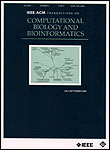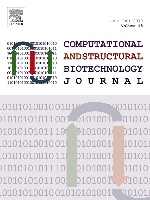
Algorithms for Molecular Biology
Scope & Guideline
Connecting minds to advance the science of life.
Introduction
Aims and Scopes
- Algorithm Development and Optimization:
The journal prioritizes research that introduces new algorithms or optimizes existing ones, particularly those that address computational challenges in bioinformatics and molecular biology. - Data Structures and Computational Efficiency:
A significant focus is placed on the design of efficient data structures that facilitate faster computations in the analysis of biological data, including genomic sequences and molecular interactions. - Statistical and Probabilistic Models:
Research involving statistical methodologies and probabilistic models is central, particularly in phylogenetics, population genetics, and evolutionary biology. - Applications in Genomics and Proteomics:
The journal emphasizes practical applications of algorithms in genomics and proteomics, including gene mapping, sequence alignment, and structural biology. - Interdisciplinary Approaches:
A unique contribution of the journal is its encouragement of interdisciplinary methodologies, combining insights from computer science, mathematics, and biology to tackle complex biological problems.
Trending and Emerging
- Machine Learning and Artificial Intelligence in Bioinformatics:
There is a growing trend towards incorporating machine learning and artificial intelligence techniques into bioinformatics, demonstrating their effectiveness in predictive modeling and data analysis. - Graph-Based Algorithms:
The use of graph-based algorithms is increasingly prevalent, particularly in the context of genomic data analysis, pangenomics, and complex biological networks. - Single-Cell Genomics and Analysis:
Research focusing on single-cell genomics is on the rise, reflecting the importance of understanding cellular heterogeneity and its implications in health and disease. - Integration of Multi-Omics Data:
There is an emerging focus on algorithms that integrate various omics data (genomics, proteomics, transcriptomics), highlighting the need for comprehensive analyses of biological systems. - Dynamic Programming in RNA Biology:
Dynamic programming approaches for RNA folding and structure prediction are increasingly emphasized, reflecting advancements in understanding RNA biology and its computational challenges.
Declining or Waning
- Traditional Phylogenetic Methods:
There is a noticeable decrease in the publication of traditional phylogenetic methods, as newer, more efficient algorithms and machine learning techniques gain traction. - Basic Sequence Alignment Techniques:
Basic sequence alignment techniques are appearing less frequently, likely due to the rise of advanced methods that incorporate structural information or machine learning. - Static Models in Population Genetics:
Research focused on static models within population genetics is waning, with a shift towards dynamic and adaptive models that better reflect real-world biological processes. - Single-Method Approaches:
The journal is moving away from studies that rely solely on a single computational method, favoring more integrative approaches that combine multiple techniques for more robust results.
Similar Journals

Genes
Fostering collaboration in the evolving landscape of genetics.Genes is a leading open-access journal published by MDPI that focuses on advancing the field of genetics and genomics. Established in 2010 and based in Basel, Switzerland, this journal has made significant strides in promoting innovative research in both clinical genetics and molecular biology. With an impact factor reflecting its relevance and quality, Genes has been classified in the Q2 quartile for Genetics and the Q3 quartile for clinical Genetics as of 2023. The journal provides an accessible platform for researchers, professionals, and students to disseminate their findings and explore emerging trends across the genetics landscape. Accessible online since its inception, Genes allows for continuous engagement and collaboration within the scientific community, fostering a deeper understanding of genetic mechanisms and their implications in health and disease.

Acta Crystallographica Section F-Structural Biology Communications
Fostering Collaboration in the World of CrystallographyActa Crystallographica Section F-Structural Biology Communications, published by the International Union of Crystallography, serves as a crucial platform for researchers in the field of structural biology. Established in 2014, this journal focuses on the dissemination of high-quality research regarding the crystallographic methods and structural analyses of biological macromolecules. Although currently positioned in various category quartiles including Q3 in Biochemistry, Biophysics, and Genetics, and even achieving Q2 in Condensed Matter Physics, the journal continually aims to enhance its influence and reach within the scientific community. The journal is an essential resource for professionals and students alike, providing insights into cutting-edge research and methodologies that can advance our understanding of complex biological systems. Accessibility is facilitated through robust online publishing platforms, although it remains beyond the open access model. Located in the United Kingdom, Acta Crystallographica Section F is dedicated to promoting the integrity of structural biology research and fostering a collaborative scholarly environment.

MOLECULAR GENETICS AND GENOMICS
Pioneering the Future of Genetic UnderstandingMOLECULAR GENETICS AND GENOMICS is a distinguished journal published by SPRINGER HEIDELBERG that serves as a pivotal platform for the communication of cutting-edge research and developments in the fields of genetics, molecular biology, and medicine. With an ISSN of 1617-4615 and an E-ISSN of 1617-4623, this journal has established itself since its inception in 1994 as a significant resource for researchers aiming to explore the complexities of genetic interactions and their implications in various biological systems. The journal is indexed in Scopus, with respectable rankings in the Genetics, Molecular Biology, and Biochemistry categories, showcasing its position within the academic community. It is categorized in the 2023 rankings as Q3 in Genetics, Q2 in Medicine (miscellaneous), and Q3 in Molecular Biology, indicating its relevance and quality in the scientific discourse. The journal also promotes open access, ensuring that researchers and professionals can easily share and advance knowledge in the rapidly evolving disciplines of molecular genetics and genomics. As the journal continues to bridge the gap between experimental and theoretical research, it presents a vital space for innovation, fostering collaborations and scholarly exchange among its readership.

NATURE REVIEWS GENETICS
Pioneering Reviews in the World of Genetics.NATURE REVIEWS GENETICS, published by NATURE PORTFOLIO, stands as a leading journal in the field of genetics, boasting a remarkable reputation reflected in its Q1 ranking across multiple categories including Genetics, Clinical Genetics, and Molecular Biology. With an impressive percentile of 99th in both Genetics and Clinical Genetics, as well as a solid rank in Molecular Biology, this journal is pivotal for researchers, professionals, and students alike who seek to stay informed on the latest advancements and comprehensive reviews in genetic research. The journal's scope encompasses a wide array of topics, providing in-depth insights from fundamental genetic principles to clinical applications, underscoring its importance in bridging basic science and medical practice. Though not an open-access publication, it remains accessible through various academic institutions, enhancing its reach and influence within the scientific community. With publication years spanning from 2000 to 2024, NATURE REVIEWS GENETICS continues to shape the future of genetics research and education.

Molecular Systems Biology
Unraveling the Mysteries of Molecular InteractionsMolecular Systems Biology, published by SpringerNature, is a premier open access journal that has been a cornerstone in advancing the fields of biological science since its inception in 2005. With its ISSN 1744-4292, this journal exemplifies high scholarly standards, boasting an impressive suite of impact factors, including Q1 rankings across various disciplines such as Agricultural and Biological Sciences, Biochemistry, Genetics and Molecular Biology, and more, highlighting its significant contribution to the scientific community. The journal offers robust access options to facilitate innovative research dissemination, reaching a global audience while maintaining a commitment to fostering collaboration and dialogue among researchers, professionals, and students. With a focus on integrating quantitative approaches to biological systems, Molecular Systems Biology plays a vital role in addressing complex biological questions, paving the way for groundbreaking discoveries and advancements in healthcare, environmental sustainability, and functional genomics.

IEEE-ACM Transactions on Computational Biology and Bioinformatics
Unlocking Complex Biological Systems Through InnovationIEEE-ACM Transactions on Computational Biology and Bioinformatics is a prestigious journal published by the IEEE Computer Society, focusing on the interdisciplinary field of computational biology and bioinformatics. Established in 2004, this journal has made significant strides in contributing to our understanding of complex biological systems through quantitative methods and computational techniques, and it spans a converged publication period through 2024. As a notable resource with an impact factor that positions it in the second quartile in the domains of Applied Mathematics, Biotechnology, and Genetics, it serves as an essential platform for researchers and professionals seeking to disseminate their findings to a global audience. The journal ranks impressively in Scopus, with Applied Mathematics holding a rank of #38 out of 635 (94th percentile) and Genetics at #86 out of 347 (75th percentile), highlighting its significant influence in the scientific community. While the journal is not open-access, it provides valuable insights and cutting-edge research that are crucial for advancing the fields of bioinformatics and computational biology, making it indispensable for students, researchers, and practitioners alike.

Journal of Algorithms & Computational Technology
Exploring New Horizons in Computational TechnologyJournal of Algorithms & Computational Technology, published by SAGE PUBLICATIONS LTD, serves as a noteworthy platform for scholars and practitioners in the realms of applied mathematics, computational mathematics, and numerical analysis. With an ISSN of 1748-3018 and an E-ISSN of 1748-3026, this Open Access journal has been disseminating high-quality research since 2007, ensuring that significant advancements in algorithmic techniques and computational methodologies are readily accessible to the global academic community. Based in the United Kingdom, this journal has steadily established itself within specialized quartiles, notably achieving Q3 ranking in Computational Mathematics and Q4 in both Applied Mathematics and Numerical Analysis for 2023, reflecting its growing influence in these fields. As the journal converges from 2011 to 2024, it aims to cater to the needs of researchers, professionals, and students by publishing innovative research that not only addresses theoretical frameworks but also provides practical applications. By leveraging its open-access model, the Journal of Algorithms & Computational Technology fosters a collaborative environment where knowledge can flourish, allowing for the continuous evolution of algorithms that drive technological advancement.

Life Science Alliance
Transforming Ideas into Impactful Science.Life Science Alliance, published by LIFE SCIENCE ALLIANCE LLC, is a premier open access journal that has been making significant contributions to the fields of Biochemistry, Genetics and Molecular Biology, Ecology, Health, Toxicology and Mutagenesis, and Plant Science since its inception in 2018. With an impressive ranking in Scopus, including Q1 quartile positions and high percentiles in relevant categories, this journal is a vital resource for researchers, professionals, and students alike who seek to advance knowledge and innovation in life sciences. The journal operates on an open access model, ensuring that research findings are freely available to the global scientific community, thereby enhancing the visibility and impact of published work. With a commitment to fostering collaboration and disseminating high-quality research, Life Science Alliance serves as an essential platform for the promotion and exchange of scientific knowledge, aiming to bridge gaps and stimulate discussions across multiple disciplines.

Computational and Structural Biotechnology Journal
Bridging Disciplines to Transform Biotechnology ResearchComputational and Structural Biotechnology Journal is a premier open-access journal published by Elsevier, focusing on the intersection of computer science and molecular biology. Since its inception in 2012, the journal has established itself as a leading platform for innovative research, featuring groundbreaking studies in biochemistry, biophysics, biotechnology, and genetics. With a remarkable Q1 ranking in multiple categories, including Biochemistry and Genetics, it stands out for its high impact, evidenced by its strong Scopus ranking percentile scores. As a vital resource for researchers, professionals, and students, the journal aims to foster the dissemination of essential findings that leverage computational techniques to explore complex biological systems. In a rapidly evolving scientific landscape, Computational and Structural Biotechnology Journal serves as an indispensable resource for those looking to contribute and stay abreast of major advancements in the field.

PLoS Genetics
Driving discoveries in genetics for a healthier tomorrow.PLoS Genetics, published by the PUBLIC LIBRARY SCIENCE, is a leading open-access journal dedicated to advancing the field of genetics, molecular biology, and related disciplines. With its ISSN of 1553-7404, this esteemed journal has been offering unrestricted access to its content since 2005, fostering a global community of researchers, professionals, and students. Situated in the United States, its contributions can be found at 1160 Battery Street, Ste 100, San Francisco, CA 94111. As of 2023, PLoS Genetics proudly holds a Q1 ranking in multiple categories including Cancer Research, Ecology, Evolution, Behavior and Systematics, Genetics, and Molecular Biology, underscoring its impact in these vital scientific areas. The journal's commitment to disseminating high-quality research is reflected in its impressive Scopus rankings, with notable positions in various fields of study, ensuring that it remains a crucial resource for cutting-edge research and innovation. By providing an open-access platform, PLoS Genetics not only enhances the visibility of genetic research but also encourages collaborations and the sharing of knowledge that can lead to significant breakthroughs in science.